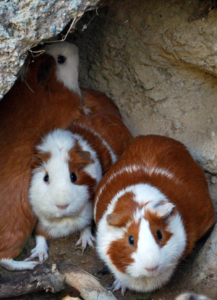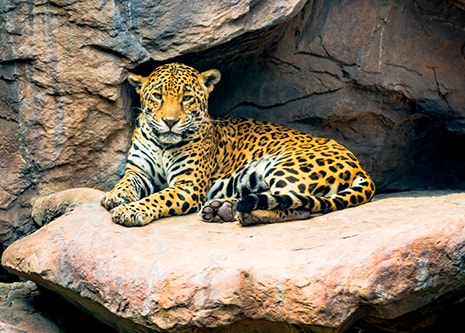
- VisitSupport Happy HollowDONATE TODAYExploreSupport Happy HollowDONATE TODAYLearnSupport Happy HollowDONATE TODAYSupportToday’s Hours: CLOSEDZoo on the Hill
Guinea pig

Scientific name: Cavia porcellus
Family: Caviidae
Order: Rodentia
Class: Mammalia
Range: Originally from the Andes Mountains of Ecuador, Peru, and Bolivia; Domesticated worldwide
Habitat: Urban
Lifespan: 4 to 6 years in captivityWhat do they look like?
Guinea pigs are rodents measuring eight to 10 inches long and weighing up to 2.5 pounds. Domestic guinea pigs come in a variety of patterns, colors, and hair types and some are bred specifically for certain characteristics. Like other rodents, guinea pigs are equipped with sharp incisors (front teeth) that grow throughout their lifetime and are constantly worn down by the grasses and hay they eat.How do they behave?
Guinea pigs are social animals and form close bonds with each other. Unlike many animals, guinea pigs are neither strictly diurnal (primarily active during the daytime) nor nocturnal (primarily active during the nighttime). Instead, they randomly scatter periods of activity with shorter periods of sleep throughout the day and night. Guinea pigs startle easily and will either hold still to avoid being detected or sprint for cover. When excited, guinea pigs often hop in the air repeatedly, a behavior that has been called “popcorning.”What do they eat?
Guinea pigs graze on grasses and hay. Most mammalian grass-eaters have long digestive tracts in order to break down food and absorb nutrients. Due to lack of a complex digestive track, guinea pigs partake in a behavior known as coprophagia (eating their own feces). Caecotrophs (soft fecal pellets) are ingested to reintroduce vitamins, fiber, and bacteria needed for digestion. At Happy Hollow they are fed grass hay, guinea pig pellets, fruits, and vegetables.How are they born?
Guinea pigs can reproduce year-round, with births peaking in spring. Females can deliver up to five litters per year of one to six pups. Gestation typically lasts 60 to 70 days and results in well-developed pups with hair, teeth, claws, and partial eyesight at birth. They are able to walk and eat solid food immediately, although they do continue to suckle from their mother to receive important nutrients and antibodies from her milk.Do wild guinea pigs exist?
Domestic guinea pigs are a species of their own. Their relatives, other members of the cavy family, exist in the wild but are classified as different species, such as the Brazilian guinea pig (Cavia aperea), the shiny guinea pig (Cavia fulgida), and the montane guinea pig (Cavia tschudii). Other close relatives include the maras, capybaras and kerodons of South America.Conservation
Domestic guinea pigs have not been evaluated by the International Union for Conservation of Nature because they have been bred by people and are often kept as pets. If you are interested in a domestic guinea pig as a pet, remember to do your research. Guinea pigs require a lot of attention, veterinary check-ups, specialized diets and care from their owners. Visit your local humane society to find people who can help you make the proper pet choice.
Zoo in the Hollow
Follow the crooked bamboo pathway down into the hollow and visit with some of the most amazing animals in the world. Where else in San José can you get up close to a stunning jaguar, lemur, meerkat or American alligator? Happy Hollow is dedicated to helping save species and preserve wildlife for future generations by participating in Species Survival Plan programs through the Association of Zoos and Aquariums.
Learn More
Education Ambassadors
From camps and classes to scout badges and sleepovers, Happy Hollow education programs have something for everyone! The zoo education program offers a broad range of hands-on, engaging programs and public presentations featuring education ambassador animals. These encounters are designed to connect you to wildlife and the conservation of their habitats around the world.
See AnimalsVisit Us Today
Plan an unforgettable experience at San Jose’s family-friendly park and zoo.
Learn more